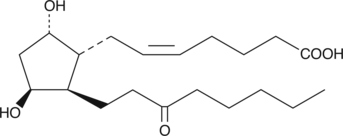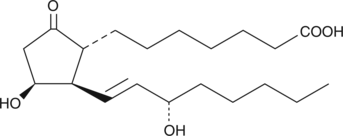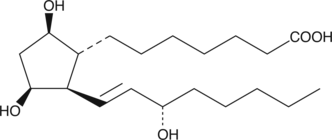Chemicals
Showing 3151–3300 of 41137 results
-
11(S)-HEDE is isolated by the chromatographic resolution of (±)11-HEDE. There are no reports of biological activity associated with 11(S)-HEDE in the literature.
Brand:CaymanSKU:37510 - 250 µgAvailable on backorder
11(S)-HEDE is isolated by the chromatographic resolution of (±)11-HEDE. There are no reports of biological activity associated with 11(S)-HEDE in the literature.
Brand:CaymanSKU:37510 - 50 µgAvailable on backorder
11(S)-HEPE is a monohydroxy fatty acid derived from EPA, theoretically by the action of COX. Although its arachidonate derived congener 11(S)-HETE has been isolated from cultured neutrophils, it is not known if similar incubations with EPA can produce 11(S)-HEPE.{1088}
Brand:CaymanSKU:32510 - 100 µgAvailable on backorder
11(S)-HEPE is a monohydroxy fatty acid derived from EPA, theoretically by the action of COX. Although its arachidonate derived congener 11(S)-HETE has been isolated from cultured neutrophils, it is not known if similar incubations with EPA can produce 11(S)-HEPE.{1088}
Brand:CaymanSKU:32510 - 25 µgAvailable on backorder
11(S)-HEPE is a monohydroxy fatty acid derived from EPA, theoretically by the action of COX. Although its arachidonate derived congener 11(S)-HETE has been isolated from cultured neutrophils, it is not known if similar incubations with EPA can produce 11(S)-HEPE.{1088}
Brand:CaymanSKU:32510 - 50 µgAvailable on backorder
The synthesis of 11-HETE by rat PMNL has been reported, but the stereochemistry of the 11-HETE produced is not defined.{1088} There are no definitive reports of a mammalian 11(S)-LO. Stereochemical assignment of the (S) enantiomer is based on comparison of chiral HPLC retention times to published results.{30214}
Brand:CaymanSKU:34510 - 100 µgAvailable on backorder
The synthesis of 11-HETE by rat PMNL has been reported, but the stereochemistry of the 11-HETE produced is not defined.{1088} There are no definitive reports of a mammalian 11(S)-LO. Stereochemical assignment of the (S) enantiomer is based on comparison of chiral HPLC retention times to published results.{30214}
Brand:CaymanSKU:34510 - 25 µgAvailable on backorder
The synthesis of 11-HETE by rat PMNL has been reported, but the stereochemistry of the 11-HETE produced is not defined.{1088} There are no definitive reports of a mammalian 11(S)-LO. Stereochemical assignment of the (S) enantiomer is based on comparison of chiral HPLC retention times to published results.{30214}
Brand:CaymanSKU:34510 - 50 µgAvailable on backorder
11(Z)-Eicosenoic acid is one of several monounsaturated 20-carbon fatty acids. The combined C20:1 isomers constitute 70% of the total fatty acid pool in jojoba seed oil isolated from plants in the Arizona desert.{32834}
Brand:CaymanSKU:20606 -Available on backorder
11(Z)-Eicosenoic acid is one of several monounsaturated 20-carbon fatty acids. The combined C20:1 isomers constitute 70% of the total fatty acid pool in jojoba seed oil isolated from plants in the Arizona desert.{32834}
Brand:CaymanSKU:20606 -Available on backorder
11(Z)-Eicosenoic acid is one of several monounsaturated 20-carbon fatty acids. The combined C20:1 isomers constitute 70% of the total fatty acid pool in jojoba seed oil isolated from plants in the Arizona desert.{32834}
Brand:CaymanSKU:20606 -Available on backorder
11(Z)-Eicosenoic acid is one of several monounsaturated 20-carbon fatty acids. The combined C20:1 isomers constitute 70% of the total fatty acid pool in jojoba seed oil isolated from plants in the Arizona desert.{32834}
Brand:CaymanSKU:20606 -Available on backorder
11(Z),14(Z)-Eicosadienoic acid is an uncommon, naturally occurring PUFA. It inhibits the binding of [3H]-LTB4 to pig neutrophil membranes with a Ki of 3 µM.{2361}
Brand:CaymanSKU:90330 - 100 mgAvailable on backorder
11(Z),14(Z)-Eicosadienoic acid is an uncommon, naturally occurring PUFA. It inhibits the binding of [3H]-LTB4 to pig neutrophil membranes with a Ki of 3 µM.{2361}
Brand:CaymanSKU:90330 - 250 mgAvailable on backorder
11(Z),14(Z)-Eicosadienoic acid is an uncommon, naturally occurring PUFA. It inhibits the binding of [3H]-LTB4 to pig neutrophil membranes with a Ki of 3 µM.{2361}
Brand:CaymanSKU:90330 - 50 mgAvailable on backorder
11(Z),14(Z)-Eicosadienoic acid is an uncommon, naturally occurring PUFA. It inhibits the binding of [3H]-LTB4 to pig neutrophil membranes with a Ki of 3 µM.{2361}
Brand:CaymanSKU:90330 - 500 mgAvailable on backorder
11(Z),14(Z)-Eicosadienoic acid ethanolamide is an ethanolamide-conjugated form of 11(Z),14(Z)-eicosadienoic acid (Item No. 90330).
Brand:CaymanSKU:31024 - 1 mgAvailable on backorder
11(Z),14(Z)-Eicosadienoic acid ethanolamide is an ethanolamide-conjugated form of 11(Z),14(Z)-eicosadienoic acid (Item No. 90330).
Brand:CaymanSKU:31024 - 5 mgAvailable on backorder
11(Z),14(Z)-Eicosadienoic acid ethanolamide is an ethanolamide-conjugated form of 11(Z),14(Z)-eicosadienoic acid (Item No. 90330).
Brand:CaymanSKU:31024 - 500 µgAvailable on backorder
11(Z),14(Z)-Eicosadienoic acid methyl ester is a more lipid soluble form of the ω-6 C20-2 fatty acid 11(Z),14(Z)-eicosadienoic acid (Item No. 90330), a naturally occurring PUFA. 11(Z),14(Z)-Eicosadienoic acid competitively inhibits inosine 5’-monophosphate dehydrogenase (Ki = 3.1 µM) and inhibits the binding of LTB4 to its receptor on neutrophils (Ki = 3.0 µM).{16478,2361} Also, serum levels of eicosadienoic acids negatively correlate with degree of sleep disturbance.{16477} Eicosadienoic acids are converted by desaturases, in vivo, to eicosatrienoic acids, which are potent vasodilators.
Brand:CaymanSKU:20750 -Available on backorder
11(Z),14(Z)-Eicosadienoic acid methyl ester is a more lipid soluble form of the ω-6 C20-2 fatty acid 11(Z),14(Z)-eicosadienoic acid (Item No. 90330), a naturally occurring PUFA. 11(Z),14(Z)-Eicosadienoic acid competitively inhibits inosine 5’-monophosphate dehydrogenase (Ki = 3.1 µM) and inhibits the binding of LTB4 to its receptor on neutrophils (Ki = 3.0 µM).{16478,2361} Also, serum levels of eicosadienoic acids negatively correlate with degree of sleep disturbance.{16477} Eicosadienoic acids are converted by desaturases, in vivo, to eicosatrienoic acids, which are potent vasodilators.
Brand:CaymanSKU:20750 -Available on backorder
11(Z),14(Z)-Eicosadienoic acid methyl ester is a more lipid soluble form of the ω-6 C20-2 fatty acid 11(Z),14(Z)-eicosadienoic acid (Item No. 90330), a naturally occurring PUFA. 11(Z),14(Z)-Eicosadienoic acid competitively inhibits inosine 5’-monophosphate dehydrogenase (Ki = 3.1 µM) and inhibits the binding of LTB4 to its receptor on neutrophils (Ki = 3.0 µM).{16478,2361} Also, serum levels of eicosadienoic acids negatively correlate with degree of sleep disturbance.{16477} Eicosadienoic acids are converted by desaturases, in vivo, to eicosatrienoic acids, which are potent vasodilators.
Brand:CaymanSKU:20750 -Available on backorder
11(Z),14(Z)-Eicosadienoic acid methyl ester is a more lipid soluble form of the ω-6 C20-2 fatty acid 11(Z),14(Z)-eicosadienoic acid (Item No. 90330), a naturally occurring PUFA. 11(Z),14(Z)-Eicosadienoic acid competitively inhibits inosine 5’-monophosphate dehydrogenase (Ki = 3.1 µM) and inhibits the binding of LTB4 to its receptor on neutrophils (Ki = 3.0 µM).{16478,2361} Also, serum levels of eicosadienoic acids negatively correlate with degree of sleep disturbance.{16477} Eicosadienoic acids are converted by desaturases, in vivo, to eicosatrienoic acids, which are potent vasodilators.
Brand:CaymanSKU:20750 -Available on backorder
Eicosatrienoic Acid (20:3ω-3) is a rare polyunsaturated fatty acid of the ω-3 series. In normal humans, it represents less than 0.25% of serum phospholipid fatty acids. However, it is one of the most active essential fatty acids when assayed for the inhibition of fatty acid elongation/desaturation reactions which convert dietary C-18 fatty acids to C-20 eicosanoid precursors.{8460}
Brand:CaymanSKU:90192 - 10 mgAvailable on backorder
Eicosatrienoic Acid (20:3ω-3) is a rare polyunsaturated fatty acid of the ω-3 series. In normal humans, it represents less than 0.25% of serum phospholipid fatty acids. However, it is one of the most active essential fatty acids when assayed for the inhibition of fatty acid elongation/desaturation reactions which convert dietary C-18 fatty acids to C-20 eicosanoid precursors.{8460}
Brand:CaymanSKU:90192 - 100 mgAvailable on backorder
Eicosatrienoic Acid (20:3ω-3) is a rare polyunsaturated fatty acid of the ω-3 series. In normal humans, it represents less than 0.25% of serum phospholipid fatty acids. However, it is one of the most active essential fatty acids when assayed for the inhibition of fatty acid elongation/desaturation reactions which convert dietary C-18 fatty acids to C-20 eicosanoid precursors.{8460}
Brand:CaymanSKU:90192 - 5 mgAvailable on backorder
Eicosatrienoic Acid (20:3ω-3) is a rare polyunsaturated fatty acid of the ω-3 series. In normal humans, it represents less than 0.25% of serum phospholipid fatty acids. However, it is one of the most active essential fatty acids when assayed for the inhibition of fatty acid elongation/desaturation reactions which convert dietary C-18 fatty acids to C-20 eicosanoid precursors.{8460}
Brand:CaymanSKU:90192 - 50 mgAvailable on backorder
11(Z),14(Z),17(Z)-Eicosatrienoic acid (Item No. 90192) is a rare ω-3 PUFA in normal humans. However, it is one of the most active essential fatty acids when assayed for the inhibition of fatty acid elongation/desaturation reactions which convert dietary C-18 fatty acids to C-20 eicosanoid precursors.{8460} 11(Z),14(Z),17(Z)-Eicosatrienoic acid methyl ester is an ester version of the free acid that may be more amenable for the formulation of fatty acid-containing diets and dietary supplements.
Brand:CaymanSKU:-Available on backorder
11(Z),14(Z),17(Z)-Eicosatrienoic acid (Item No. 90192) is a rare ω-3 PUFA in normal humans. However, it is one of the most active essential fatty acids when assayed for the inhibition of fatty acid elongation/desaturation reactions which convert dietary C-18 fatty acids to C-20 eicosanoid precursors.{8460} 11(Z),14(Z),17(Z)-Eicosatrienoic acid methyl ester is an ester version of the free acid that may be more amenable for the formulation of fatty acid-containing diets and dietary supplements.
Brand:CaymanSKU:-Available on backorder
11(Z),14(Z),17(Z)-Eicosatrienoic acid (Item No. 90192) is a rare ω-3 PUFA in normal humans. However, it is one of the most active essential fatty acids when assayed for the inhibition of fatty acid elongation/desaturation reactions which convert dietary C-18 fatty acids to C-20 eicosanoid precursors.{8460} 11(Z),14(Z),17(Z)-Eicosatrienoic acid methyl ester is an ester version of the free acid that may be more amenable for the formulation of fatty acid-containing diets and dietary supplements.
Brand:CaymanSKU:-Available on backorder
11(Z),14(Z),17(Z)-Eicosatrienoic acid (Item No. 90192) is a rare ω-3 PUFA in normal humans. However, it is one of the most active essential fatty acids when assayed for the inhibition of fatty acid elongation/desaturation reactions which convert dietary C-18 fatty acids to C-20 eicosanoid precursors.{8460} 11(Z),14(Z),17(Z)-Eicosatrienoic acid methyl ester is an ester version of the free acid that may be more amenable for the formulation of fatty acid-containing diets and dietary supplements.
Brand:CaymanSKU:-Available on backorder
11β-13,14-dihydro-15-keto PGF2α is a metabolite of PGD2 (Item No. 12010) in the 15-hydroxy PGDH pathway.{11174,11176} Infusion or inhalation of tritiated PGD2 in normal males results in the appearance of peak levels of both 11β-PGF2α, as the immediate product, and 11β-13,14-dihydro-15-keto PGF2α in the plasma within 10 minutes.{11174} Homogenates of human lung metabolize PGD2 first to 11β-PGF2α and then to 11β-15-keto-PGF2α in the presence of NAD+, but not 11β-13,14-dihydro-15-keto PGF2α.{11176} Guinea pig liver and kidney homogenates metabolize PGD2 to 11β-13,14-dihydro-15-keto PGF2α, via 11β-PGF2α, in the presence of NAD+ and NADP+.{11176}
Brand:CaymanSKU:-Out of stock
11β-13,14-dihydro-15-keto PGF2α is a metabolite of PGD2 (Item No. 12010) in the 15-hydroxy PGDH pathway.{11174,11176} Infusion or inhalation of tritiated PGD2 in normal males results in the appearance of peak levels of both 11β-PGF2α, as the immediate product, and 11β-13,14-dihydro-15-keto PGF2α in the plasma within 10 minutes.{11174} Homogenates of human lung metabolize PGD2 first to 11β-PGF2α and then to 11β-15-keto-PGF2α in the presence of NAD+, but not 11β-13,14-dihydro-15-keto PGF2α.{11176} Guinea pig liver and kidney homogenates metabolize PGD2 to 11β-13,14-dihydro-15-keto PGF2α, via 11β-PGF2α, in the presence of NAD+ and NADP+.{11176}
Brand:CaymanSKU:-Out of stock
11β-13,14-dihydro-15-keto PGF2α is a metabolite of PGD2 (Item No. 12010) in the 15-hydroxy PGDH pathway.{11174,11176} Infusion or inhalation of tritiated PGD2 in normal males results in the appearance of peak levels of both 11β-PGF2α, as the immediate product, and 11β-13,14-dihydro-15-keto PGF2α in the plasma within 10 minutes.{11174} Homogenates of human lung metabolize PGD2 first to 11β-PGF2α and then to 11β-15-keto-PGF2α in the presence of NAD+, but not 11β-13,14-dihydro-15-keto PGF2α.{11176} Guinea pig liver and kidney homogenates metabolize PGD2 to 11β-13,14-dihydro-15-keto PGF2α, via 11β-PGF2α, in the presence of NAD+ and NADP+.{11176}
Brand:CaymanSKU:-Out of stock
Misoprostol is a widely sold analog of prostaglandin E1 (PGE1) which has potent but relatively non-selective agonist activity with respect to the prostanoid EP receptor subgroup.{8322} Misoprostol has been used therapeutically for many years in humans for the treatment of gastric ulcer disease under the Searle tradename Cytotec.{2958} 11β-Misoprostol is one of several impurities which are possible in the production of commercial lots of bulk misoprostol, and is somewhat difficult to distinguish from other impurities such as 8-iso misoprostol. The pharmacology and EP receptor binding affinity for 11β-misoprostol have not been published.
Brand:CaymanSKU:-Misoprostol is a widely sold analog of prostaglandin E1 (PGE1) which has potent but relatively non-selective agonist activity with respect to the prostanoid EP receptor subgroup.{8322} Misoprostol has been used therapeutically for many years in humans for the treatment of gastric ulcer disease under the Searle tradename Cytotec.{2958} 11β-Misoprostol is one of several impurities which are possible in the production of commercial lots of bulk misoprostol, and is somewhat difficult to distinguish from other impurities such as 8-iso misoprostol. The pharmacology and EP receptor binding affinity for 11β-misoprostol have not been published.
Brand:CaymanSKU:-11β-Prostaglandin E1 (11β-PGE1) is an epimerized form of PGE1 at the C-11 position. 11β-PGE1 is a less potent isomer of PGE1. It is 13% and 3.6% as potent as PGE1 in contracting the rat uterus and guinea pig ileum, respectively.{4158}
Brand:CaymanSKU:-11β-Prostaglandin E1 (11β-PGE1) is an epimerized form of PGE1 at the C-11 position. 11β-PGE1 is a less potent isomer of PGE1. It is 13% and 3.6% as potent as PGE1 in contracting the rat uterus and guinea pig ileum, respectively.{4158}
Brand:CaymanSKU:-11β-Prostaglandin E1 (11β-PGE1) is an epimerized form of PGE1 at the C-11 position. 11β-PGE1 is a less potent isomer of PGE1. It is 13% and 3.6% as potent as PGE1 in contracting the rat uterus and guinea pig ileum, respectively.{4158}
Brand:CaymanSKU:-11β-PGE2 is the C-11 epimer of PGE2. It is a moderate inhibitor of PGE2 binding to rat hypothalamic membranes with a Ki value of 53 nM.{1924} 11β-PGE2 also stimulates bone resorption in rats at concentrations of 10-8 to 10-6 M which is similar to PGE2.{2052} 11β-PGE2 inhibits PGE2 binding to the prostaglandin transporter protein with a Ki of 56 nM.{3806}
Brand:CaymanSKU:-11β-PGE2 is the C-11 epimer of PGE2. It is a moderate inhibitor of PGE2 binding to rat hypothalamic membranes with a Ki value of 53 nM.{1924} 11β-PGE2 also stimulates bone resorption in rats at concentrations of 10-8 to 10-6 M which is similar to PGE2.{2052} 11β-PGE2 inhibits PGE2 binding to the prostaglandin transporter protein with a Ki of 56 nM.{3806}
Brand:CaymanSKU:-11β-PGE2 is the C-11 epimer of PGE2. It is a moderate inhibitor of PGE2 binding to rat hypothalamic membranes with a Ki value of 53 nM.{1924} 11β-PGE2 also stimulates bone resorption in rats at concentrations of 10-8 to 10-6 M which is similar to PGE2.{2052} 11β-PGE2 inhibits PGE2 binding to the prostaglandin transporter protein with a Ki of 56 nM.{3806}
Brand:CaymanSKU:-11β-PGE2 is the C-11 epimer of PGE2. It is a moderate inhibitor of PGE2 binding to rat hypothalamic membranes with a Ki value of 53 nM.{1924} 11β-PGE2 also stimulates bone resorption in rats at concentrations of 10-8 to 10-6 M which is similar to PGE2.{2052} 11β-PGE2 inhibits PGE2 binding to the prostaglandin transporter protein with a Ki of 56 nM.{3806}
Brand:CaymanSKU:-11β-PGF1β is the stereoisomer of PGF1α with both C-9 and C-11 hydroxyls inverted. There are no published reports on the biological activity of this compound. 11β-PGF1β is the stereoisomer of PGF1α with both C-9 and C-11 hydroxyls inverted.
Brand:CaymanSKU:-11β-PGF1β is the stereoisomer of PGF1α with both C-9 and C-11 hydroxyls inverted. There are no published reports on the biological activity of this compound. 11β-PGF1β is the stereoisomer of PGF1α with both C-9 and C-11 hydroxyls inverted.
Brand:CaymanSKU:-11β-Prostaglandin F2α (11β-PGF2α) is the primary metabolite of PGD2 (Item No. 12010).{57057} It is formed from PGD2 via the NADPH-dependent aldo-keto reductase PGF synthase (PGFS; Item No. 10007940) in the liver or lung.{57058} 11β-PGF2α induces contraction of isolated cat iris sphincter, which endogenously expresses high levels of PGF2α (FP) receptors, with an EC50 value of 0.045 µM.{57057} It also induces contraction of isolated human bronchial smooth muscle when used at concentrations ranging from 0.1 to 30 µM.{1756} 11β-PGF2α (0.1 and 1 µM) induces phosphorylation of ERK and CREB, as well as increases the viability of MCF-7 breast cancer cells stably expressing the FP receptor when used at concentrations of 0.1 and 1 µM.{57059}
Brand:CaymanSKU:-Out of stock
11β-Prostaglandin F2α (11β-PGF2α) is the primary metabolite of PGD2 (Item No. 12010).{57057} It is formed from PGD2 via the NADPH-dependent aldo-keto reductase PGF synthase (PGFS; Item No. 10007940) in the liver or lung.{57058} 11β-PGF2α induces contraction of isolated cat iris sphincter, which endogenously expresses high levels of PGF2α (FP) receptors, with an EC50 value of 0.045 µM.{57057} It also induces contraction of isolated human bronchial smooth muscle when used at concentrations ranging from 0.1 to 30 µM.{1756} 11β-PGF2α (0.1 and 1 µM) induces phosphorylation of ERK and CREB, as well as increases the viability of MCF-7 breast cancer cells stably expressing the FP receptor when used at concentrations of 0.1 and 1 µM.{57059}
Brand:CaymanSKU:-Out of stock
11β-Prostaglandin F2α (11β-PGF2α) is the primary metabolite of PGD2 (Item No. 12010).{57057} It is formed from PGD2 via the NADPH-dependent aldo-keto reductase PGF synthase (PGFS; Item No. 10007940) in the liver or lung.{57058} 11β-PGF2α induces contraction of isolated cat iris sphincter, which endogenously expresses high levels of PGF2α (FP) receptors, with an EC50 value of 0.045 µM.{57057} It also induces contraction of isolated human bronchial smooth muscle when used at concentrations ranging from 0.1 to 30 µM.{1756} 11β-PGF2α (0.1 and 1 µM) induces phosphorylation of ERK and CREB, as well as increases the viability of MCF-7 breast cancer cells stably expressing the FP receptor when used at concentrations of 0.1 and 1 µM.{57059}
Brand:CaymanSKU:-Out of stock
11β-Prostaglandin F2α ethanolamide (11β-PGF2α-EA) is the theoretical hepatic metabolite of PGD2-EA, produced during COX-2 metabolism of the endogenous cannabinoid AEA which is found in brain, liver, and other mammalian tissues.{2415} AEA can be used directly by COX-2 and specific PG synthase to produce ethanolamide congeners of the classical PGs.{5089,11045} PGD2-EA is formed in activated RAW 264.7 cells treated with AEA.{11045}
Brand:CaymanSKU:-Out of stock
11β-Prostaglandin F2α ethanolamide (11β-PGF2α-EA) is the theoretical hepatic metabolite of PGD2-EA, produced during COX-2 metabolism of the endogenous cannabinoid AEA which is found in brain, liver, and other mammalian tissues.{2415} AEA can be used directly by COX-2 and specific PG synthase to produce ethanolamide congeners of the classical PGs.{5089,11045} PGD2-EA is formed in activated RAW 264.7 cells treated with AEA.{11045}
Brand:CaymanSKU:-Out of stock
11β-Prostaglandin F2α ethanolamide (11β-PGF2α-EA) is the theoretical hepatic metabolite of PGD2-EA, produced during COX-2 metabolism of the endogenous cannabinoid AEA which is found in brain, liver, and other mammalian tissues.{2415} AEA can be used directly by COX-2 and specific PG synthase to produce ethanolamide congeners of the classical PGs.{5089,11045} PGD2-EA is formed in activated RAW 264.7 cells treated with AEA.{11045}
Brand:CaymanSKU:-Out of stock
11β-Prostaglandin F2α (11β-PGF2α) is the primary plasma metabolite of PGD2 (Item Nos. 12010 | 10007202) in vivo.{493} Normal human urinary excretion of 11β-PGF2α is about 54 ng/mmol creatinine, which is increased nearly 3-fold upon allergen-induced bronchoconstriction in asthmatics.{3519} It is equipotent to PGF2α (Item Nos. 16010 | 10007221) in inducing human bronchial smooth muscle contractions and inhibition of adipose differentiation.{1756,2053} 11β-PGF2α inhibits ADP or thrombin-induced human platelet aggregation at concentrations of 0.14-2.8 µM.{494} 11β-PGF2α MaxSpec® standard is a quantitative grade standard of 11β-PGF2α (Item No. 16520) that has been prepared specifically for mass spectrometry or any application where quantitative reproducibility is required. The solution has been prepared gravimetrically and is supplied in a deactivated glass ampule sealed under argon. The concentration was verified by comparison to an independently prepared calibration standard. This 11β-PGF2α MaxSpec® standard is guaranteed to meet identity, purity, stability, and concentration specifications and is provided with a batch-specific certificate of analysis. Ongoing stability testing is performed to ensure the concentration remains accurate throughout the shelf life of the product. Note: The amount of solution added to the vial is in excess of the listed amount. Therefore, it is necessary to accurately measure volumes for preparation of calibration standards. Follow recommended storage and handling conditions to maintain product quality.
Brand:CaymanSKU:10007224 - 100 µgAvailable on backorder
11β-Prostaglandin F2α-d4 (11β-PGF2α-d4) is intended for use as an internal standard for the quantification of 11β-PGF2α (Item No. 16520) by GC- or LC-MS. 11β-PGF2α is the primary metabolite of PGD2 (Item No. 12010).{57057} It is formed from PGD2 via the NADPH-dependent aldo-keto reductase PGF synthase (PGFS; Item No. 10007940) in the liver or lung.{57058} 11β-PGF2α induces contraction of isolated cat iris sphincter, which endogenously expresses high levels of PGF2α (FP) receptors, with an EC50 value of 0.045 µM.{57057} It also induces contraction of isolated human bronchial smooth muscle when used at concentrations ranging from 0.1 to 30 µM.{1756} 11β-PGF2α (0.1 and 1 µM) induces phosphorylation of ERK and CREB, as well as increases the viability of MCF-7 breast cancer cells stably expressing the FP receptor when used at concentrations of 0.1 and 1 µM.{57059}
Brand:CaymanSKU:10008989 - 100 µgAvailable on backorder
11β-Prostaglandin F2α-d4 (11β-PGF2α-d4) is intended for use as an internal standard for the quantification of 11β-PGF2α (Item No. 16520) by GC- or LC-MS. 11β-PGF2α is the primary metabolite of PGD2 (Item No. 12010).{57057} It is formed from PGD2 via the NADPH-dependent aldo-keto reductase PGF synthase (PGFS; Item No. 10007940) in the liver or lung.{57058} 11β-PGF2α induces contraction of isolated cat iris sphincter, which endogenously expresses high levels of PGF2α (FP) receptors, with an EC50 value of 0.045 µM.{57057} It also induces contraction of isolated human bronchial smooth muscle when used at concentrations ranging from 0.1 to 30 µM.{1756} 11β-PGF2α (0.1 and 1 µM) induces phosphorylation of ERK and CREB, as well as increases the viability of MCF-7 breast cancer cells stably expressing the FP receptor when used at concentrations of 0.1 and 1 µM.{57059}
Brand:CaymanSKU:10008989 - 50 µgAvailable on backorder
11β-Prostaglandin F2α-d4 (11β-PGF2α-d4) is intended for use as an internal standard for the quantification of 11β-PGF2α (Item No. 16520) by GC- or LC-MS. 11β-PGF2α is the primary metabolite of PGD2 (Item No. 12010).{57057} It is formed from PGD2 via the NADPH-dependent aldo-keto reductase PGF synthase (PGFS; Item No. 10007940) in the liver or lung.{57058} 11β-PGF2α induces contraction of isolated cat iris sphincter, which endogenously expresses high levels of PGF2α (FP) receptors, with an EC50 value of 0.045 µM.{57057} It also induces contraction of isolated human bronchial smooth muscle when used at concentrations ranging from 0.1 to 30 µM.{1756} 11β-PGF2α (0.1 and 1 µM) induces phosphorylation of ERK and CREB, as well as increases the viability of MCF-7 breast cancer cells stably expressing the FP receptor when used at concentrations of 0.1 and 1 µM.{57059}
Brand:CaymanSKU:10008989 - 500 µgAvailable on backorder
12-Bromododecanoic acid is a halogenated form of lauric acid (Item No. 10006626). It has been used in the synthesis of clickable forms of myristic acid (Item No. 13351) and as a model fatty acid ligand to determine the X-ray crystal structure of bovine β-lactoglobulin-ligand complexes.{54256,54257} 12-Bromododecanoic acid (10 µg/ml) reduces virion DNA in the culture supernatant of primary hepatocytes isolated from a duckling model of hepatitis B virus (HBV) infection and inhibits HIV replication in CEM-SS T cells (EC50 = 38 µM).{54258}
Brand:CaymanSKU:30465 - 1 gAvailable on backorder
12-Bromododecanoic acid is a halogenated form of lauric acid (Item No. 10006626). It has been used in the synthesis of clickable forms of myristic acid (Item No. 13351) and as a model fatty acid ligand to determine the X-ray crystal structure of bovine β-lactoglobulin-ligand complexes.{54256,54257} 12-Bromododecanoic acid (10 µg/ml) reduces virion DNA in the culture supernatant of primary hepatocytes isolated from a duckling model of hepatitis B virus (HBV) infection and inhibits HIV replication in CEM-SS T cells (EC50 = 38 µM).{54258}
Brand:CaymanSKU:30465 - 250 mgAvailable on backorder
12-Bromododecanoic acid is a halogenated form of lauric acid (Item No. 10006626). It has been used in the synthesis of clickable forms of myristic acid (Item No. 13351) and as a model fatty acid ligand to determine the X-ray crystal structure of bovine β-lactoglobulin-ligand complexes.{54256,54257} 12-Bromododecanoic acid (10 µg/ml) reduces virion DNA in the culture supernatant of primary hepatocytes isolated from a duckling model of hepatitis B virus (HBV) infection and inhibits HIV replication in CEM-SS T cells (EC50 = 38 µM).{54258}
Brand:CaymanSKU:30465 - 500 mgAvailable on backorder
12-Deoxywithastramonolide is a withanolide found in W. somnifera roots.{37258} It has anti-inflammatory activity, reducing Tnf-α and increasing Il-10 production in mice following oral administration at doses ranging from 50-200 mg/kg. 12-Deoxywithastramonolide also reduces the growth of A549 lung and HT-29 colorectal cancer cells (IC50s = 47.1 and 29.8 μM, respectively).{37259}
Brand:CaymanSKU:11669 - 1 mgAvailable on backorder
12-Deoxywithastramonolide is a withanolide found in W. somnifera roots.{37258} It has anti-inflammatory activity, reducing Tnf-α and increasing Il-10 production in mice following oral administration at doses ranging from 50-200 mg/kg. 12-Deoxywithastramonolide also reduces the growth of A549 lung and HT-29 colorectal cancer cells (IC50s = 47.1 and 29.8 μM, respectively).{37259}
Brand:CaymanSKU:11669 - 10 mgAvailable on backorder
12-Deoxywithastramonolide is a withanolide found in W. somnifera roots.{37258} It has anti-inflammatory activity, reducing Tnf-α and increasing Il-10 production in mice following oral administration at doses ranging from 50-200 mg/kg. 12-Deoxywithastramonolide also reduces the growth of A549 lung and HT-29 colorectal cancer cells (IC50s = 47.1 and 29.8 μM, respectively).{37259}
Brand:CaymanSKU:11669 - 5 mgAvailable on backorder
12-Doxyl stearic acid is a form of stearic acid (Item No. 10011298) that contains a 4,4-dimethyl-3-oxazolinyloxy (DOXYL) group, creating a hydrophobic spin label. It is commonly used to study molecular aspects of membranes and hydrophobic proteins.{31347,31348,31349}
Brand:CaymanSKU:-Available on backorder
12-Doxyl stearic acid is a form of stearic acid (Item No. 10011298) that contains a 4,4-dimethyl-3-oxazolinyloxy (DOXYL) group, creating a hydrophobic spin label. It is commonly used to study molecular aspects of membranes and hydrophobic proteins.{31347,31348,31349}
Brand:CaymanSKU:-Available on backorder
12-Doxyl stearic acid is a form of stearic acid (Item No. 10011298) that contains a 4,4-dimethyl-3-oxazolinyloxy (DOXYL) group, creating a hydrophobic spin label. It is commonly used to study molecular aspects of membranes and hydrophobic proteins.{31347,31348,31349}
Brand:CaymanSKU:-Available on backorder
12-Doxyl stearic acid is a form of stearic acid (Item No. 10011298) that contains a 4,4-dimethyl-3-oxazolinyloxy (DOXYL) group, creating a hydrophobic spin label. It is commonly used to study molecular aspects of membranes and hydrophobic proteins.{31347,31348,31349}
Brand:CaymanSKU:-Available on backorder
Leukotriene B4 (LTB4) compounds are produced by both enzymatic and non-enzymatic processes. The products of enzymatic origin, via Leukotriene A4 (LTA4) hydrolase, are stereospecifically 12(R). Non-enzymatic hydrolysis products are 50:50 mixtures at C-12, but are almost exclusively trans at C-6. Thus, the non-enzymatic hydrolysis product of LTA4 is 6-trans-12-epi LTB4. 12-epi LTB4 is an isomer which would not be expected to occur in either non-enzymatic hydrolysis products, or in the enzymatic products of LTA4 hydrolase.{2784} Compared to LTB4, 12-epi LTB4 has significantly reduced activity for the LTB4 receptor on human neutrophils (IC50 of 7.5 mM),{11164} and on guinea pig lung membranes with a (Ki of 4.7 mM).{11162} 12-epi LTB4 is an weak agonist at both the recombinant human BLT1 and BLT2 receptors, requiring approximately 10 mM for full activation of the receptor.{9270}
Brand:CaymanSKU:20135 -Available on backorder
Leukotriene B4 (LTB4) compounds are produced by both enzymatic and non-enzymatic processes. The products of enzymatic origin, via Leukotriene A4 (LTA4) hydrolase, are stereospecifically 12(R). Non-enzymatic hydrolysis products are 50:50 mixtures at C-12, but are almost exclusively trans at C-6. Thus, the non-enzymatic hydrolysis product of LTA4 is 6-trans-12-epi LTB4. 12-epi LTB4 is an isomer which would not be expected to occur in either non-enzymatic hydrolysis products, or in the enzymatic products of LTA4 hydrolase.{2784} Compared to LTB4, 12-epi LTB4 has significantly reduced activity for the LTB4 receptor on human neutrophils (IC50 of 7.5 mM),{11164} and on guinea pig lung membranes with a (Ki of 4.7 mM).{11162} 12-epi LTB4 is an weak agonist at both the recombinant human BLT1 and BLT2 receptors, requiring approximately 10 mM for full activation of the receptor.{9270}
Brand:CaymanSKU:20135 -Available on backorder
Leukotriene B4 (LTB4) compounds are produced by both enzymatic and non-enzymatic processes. The products of enzymatic origin, via Leukotriene A4 (LTA4) hydrolase, are stereospecifically 12(R). Non-enzymatic hydrolysis products are 50:50 mixtures at C-12, but are almost exclusively trans at C-6. Thus, the non-enzymatic hydrolysis product of LTA4 is 6-trans-12-epi LTB4. 12-epi LTB4 is an isomer which would not be expected to occur in either non-enzymatic hydrolysis products, or in the enzymatic products of LTA4 hydrolase.{2784} Compared to LTB4, 12-epi LTB4 has significantly reduced activity for the LTB4 receptor on human neutrophils (IC50 of 7.5 mM),{11164} and on guinea pig lung membranes with a (Ki of 4.7 mM).{11162} 12-epi LTB4 is an weak agonist at both the recombinant human BLT1 and BLT2 receptors, requiring approximately 10 mM for full activation of the receptor.{9270}
Brand:CaymanSKU:20135 -Available on backorder
12-hydroxy Lauric acid is a hydroxylated fatty acid that has been found in honey bee royal jelly.{53145} It is active against S. aureus, B. subtilis, B. cereus, E. coli, and P. aeruginosa bacteria (MICs = 6.25-125 μg/ml) and the fungus C. albicans (MIC = 15.63 μg/ml).
Brand:CaymanSKU:28494 - 1 gAvailable on backorder
12-hydroxy Lauric acid is a hydroxylated fatty acid that has been found in honey bee royal jelly.{53145} It is active against S. aureus, B. subtilis, B. cereus, E. coli, and P. aeruginosa bacteria (MICs = 6.25-125 μg/ml) and the fungus C. albicans (MIC = 15.63 μg/ml).
Brand:CaymanSKU:28494 - 10 gAvailable on backorder
12-hydroxy Lauric acid is a hydroxylated fatty acid that has been found in honey bee royal jelly.{53145} It is active against S. aureus, B. subtilis, B. cereus, E. coli, and P. aeruginosa bacteria (MICs = 6.25-125 μg/ml) and the fungus C. albicans (MIC = 15.63 μg/ml).
Brand:CaymanSKU:28494 - 25 gAvailable on backorder
12-hydroxy Lauric acid is a hydroxylated fatty acid that has been found in honey bee royal jelly.{53145} It is active against S. aureus, B. subtilis, B. cereus, E. coli, and P. aeruginosa bacteria (MICs = 6.25-125 μg/ml) and the fungus C. albicans (MIC = 15.63 μg/ml).
Brand:CaymanSKU:28494 - 5 gAvailable on backorder
12-keto Lithocholic acid is a metabolite of the secondary bile acid deoxycholic acid (DCA; Item Nos. 20756 | 18231).{46886,46887} Fecal levels of 12-keto lithocholic acid are elevated in rats fed a diet supplemented with cholic acid (Item No. 20250) or DCA compared with rats fed a control diet or a diet supplemented with cholesterol (Item No. 9003100), hyodeoxycholic acid (HDCA; Item No. 20294), or lithocholic acid (LCA; Item No. 20253).{46887} 12-keto Lithocholic acid activates the human pregnane X receptor (PXR; EC50 = 31.3 μM in a cell-based transactivation assay).{46888} 12-keto Lithocholic acid levels are increased in duodenal bile from patients with type 2 diabetes.{46889}
Brand:CaymanSKU:29547 - 10 mgAvailable on backorder
12-keto Lithocholic acid is a metabolite of the secondary bile acid deoxycholic acid (DCA; Item Nos. 20756 | 18231).{46886,46887} Fecal levels of 12-keto lithocholic acid are elevated in rats fed a diet supplemented with cholic acid (Item No. 20250) or DCA compared with rats fed a control diet or a diet supplemented with cholesterol (Item No. 9003100), hyodeoxycholic acid (HDCA; Item No. 20294), or lithocholic acid (LCA; Item No. 20253).{46887} 12-keto Lithocholic acid activates the human pregnane X receptor (PXR; EC50 = 31.3 μM in a cell-based transactivation assay).{46888} 12-keto Lithocholic acid levels are increased in duodenal bile from patients with type 2 diabetes.{46889}
Brand:CaymanSKU:29547 - 25 mgAvailable on backorder
12-keto Lithocholic acid is a metabolite of the secondary bile acid deoxycholic acid (DCA; Item Nos. 20756 | 18231).{46886,46887} Fecal levels of 12-keto lithocholic acid are elevated in rats fed a diet supplemented with cholic acid (Item No. 20250) or DCA compared with rats fed a control diet or a diet supplemented with cholesterol (Item No. 9003100), hyodeoxycholic acid (HDCA; Item No. 20294), or lithocholic acid (LCA; Item No. 20253).{46887} 12-keto Lithocholic acid activates the human pregnane X receptor (PXR; EC50 = 31.3 μM in a cell-based transactivation assay).{46888} 12-keto Lithocholic acid levels are increased in duodenal bile from patients with type 2 diabetes.{46889}
Brand:CaymanSKU:29547 - 5 mgAvailable on backorder
12-keto Lithocholic acid is a metabolite of the secondary bile acid deoxycholic acid (DCA; Item Nos. 20756 | 18231).{46886,46887} Fecal levels of 12-keto lithocholic acid are elevated in rats fed a diet supplemented with cholic acid (Item No. 20250) or DCA compared with rats fed a control diet or a diet supplemented with cholesterol (Item No. 9003100), hyodeoxycholic acid (HDCA; Item No. 20294), or lithocholic acid (LCA; Item No. 20253).{46887} 12-keto Lithocholic acid activates the human pregnane X receptor (PXR; EC50 = 31.3 μM in a cell-based transactivation assay).{46888} 12-keto Lithocholic acid levels are increased in duodenal bile from patients with type 2 diabetes.{46889}
Brand:CaymanSKU:29547 - 50 mgAvailable on backorder
12-methyl Myristic acid is a methylated fatty acid that has been found in bacteria, dairy products, wild-caught and farm-raised saltwater fish, and mouse subcutaneous adipose tissue.{41660,41661,41662,41663} In vitro, 12-methyl myristic acid (0.625-40 μg/ml) has antifouling activity, reducing larval settlement of H. elegans in a concentration-dependent manner.{41664} Levels of 12-methyl myristic acid are decreased in mice fed a high-fat diet compared to mice fed a standard diet.{41663} [Matreya, LLC. Catalog No. 1615]
Brand:CaymanSKU:24817 - 1 mgAvailable on backorder
12-methyl Myristic acid is a methylated fatty acid that has been found in bacteria, dairy products, wild-caught and farm-raised saltwater fish, and mouse subcutaneous adipose tissue.{41660,41661,41662,41663} In vitro, 12-methyl myristic acid (0.625-40 μg/ml) has antifouling activity, reducing larval settlement of H. elegans in a concentration-dependent manner.{41664} Levels of 12-methyl myristic acid are decreased in mice fed a high-fat diet compared to mice fed a standard diet.{41663} [Matreya, LLC. Catalog No. 1615]
Brand:CaymanSKU:24817 - 10 mgAvailable on backorder
12-methyl Myristic acid is a methylated fatty acid that has been found in bacteria, dairy products, wild-caught and farm-raised saltwater fish, and mouse subcutaneous adipose tissue.{41660,41661,41662,41663} In vitro, 12-methyl myristic acid (0.625-40 μg/ml) has antifouling activity, reducing larval settlement of H. elegans in a concentration-dependent manner.{41664} Levels of 12-methyl myristic acid are decreased in mice fed a high-fat diet compared to mice fed a standard diet.{41663} [Matreya, LLC. Catalog No. 1615]
Brand:CaymanSKU:24817 - 5 mgAvailable on backorder
12-methyl Myristic acid methyl ester is a methylated fatty acid methyl ester that has been found in vermicomposts of cattle manure, carica papaya leaves, and cuticular wax of K. africana.{41652,41653,41654} It is a volatile compound in lipid-lowering granulated tea.{41655} Levels of 12-methyl myristic acid methyl ester are decreased in T. cruzi treated with nifurtimox (Item No. 21784) compared to non-treated controls.{41656} [Matreya, LLC. Catalog No. 1612]
Brand:CaymanSKU:24818 - 1 mgAvailable on backorder
12-methyl Myristic acid methyl ester is a methylated fatty acid methyl ester that has been found in vermicomposts of cattle manure, carica papaya leaves, and cuticular wax of K. africana.{41652,41653,41654} It is a volatile compound in lipid-lowering granulated tea.{41655} Levels of 12-methyl myristic acid methyl ester are decreased in T. cruzi treated with nifurtimox (Item No. 21784) compared to non-treated controls.{41656} [Matreya, LLC. Catalog No. 1612]
Brand:CaymanSKU:24818 - 10 mgAvailable on backorder

























